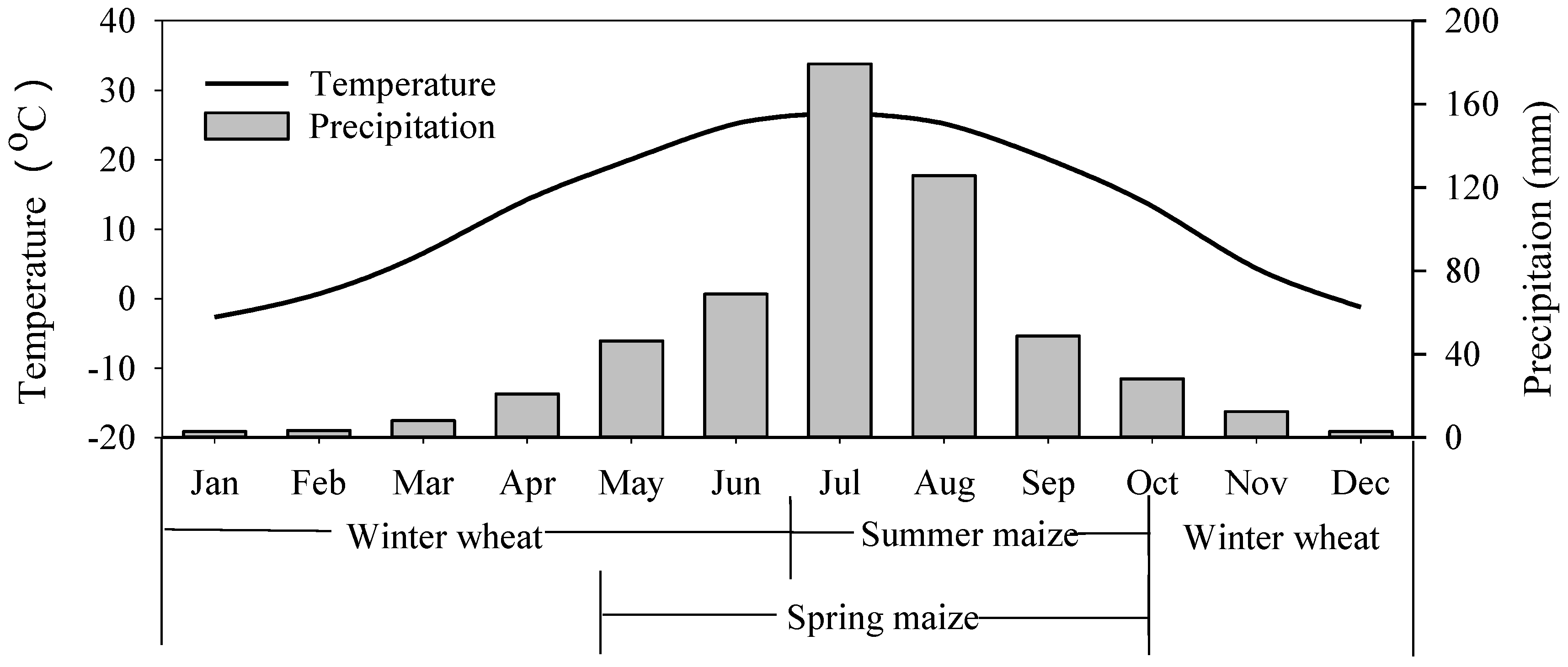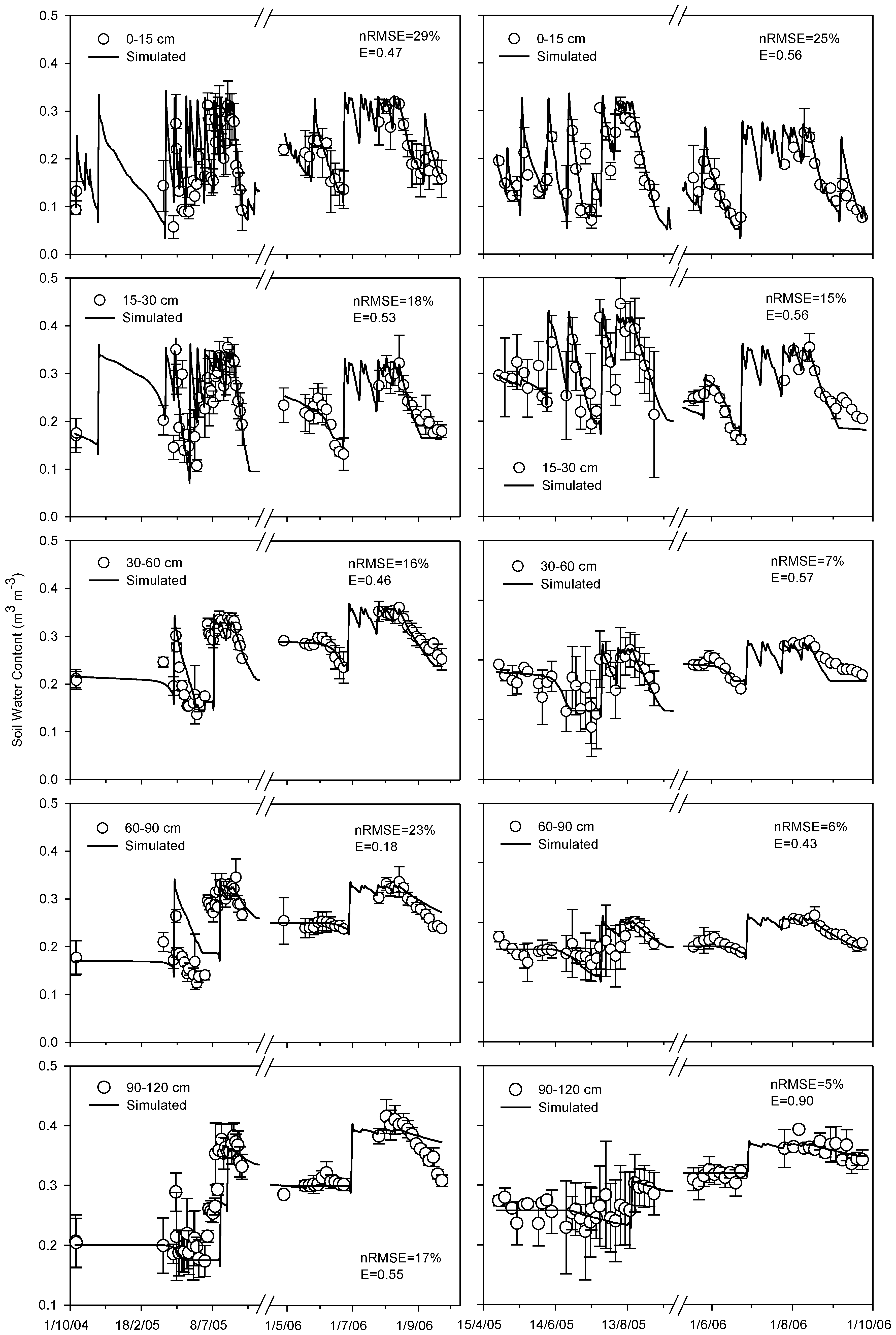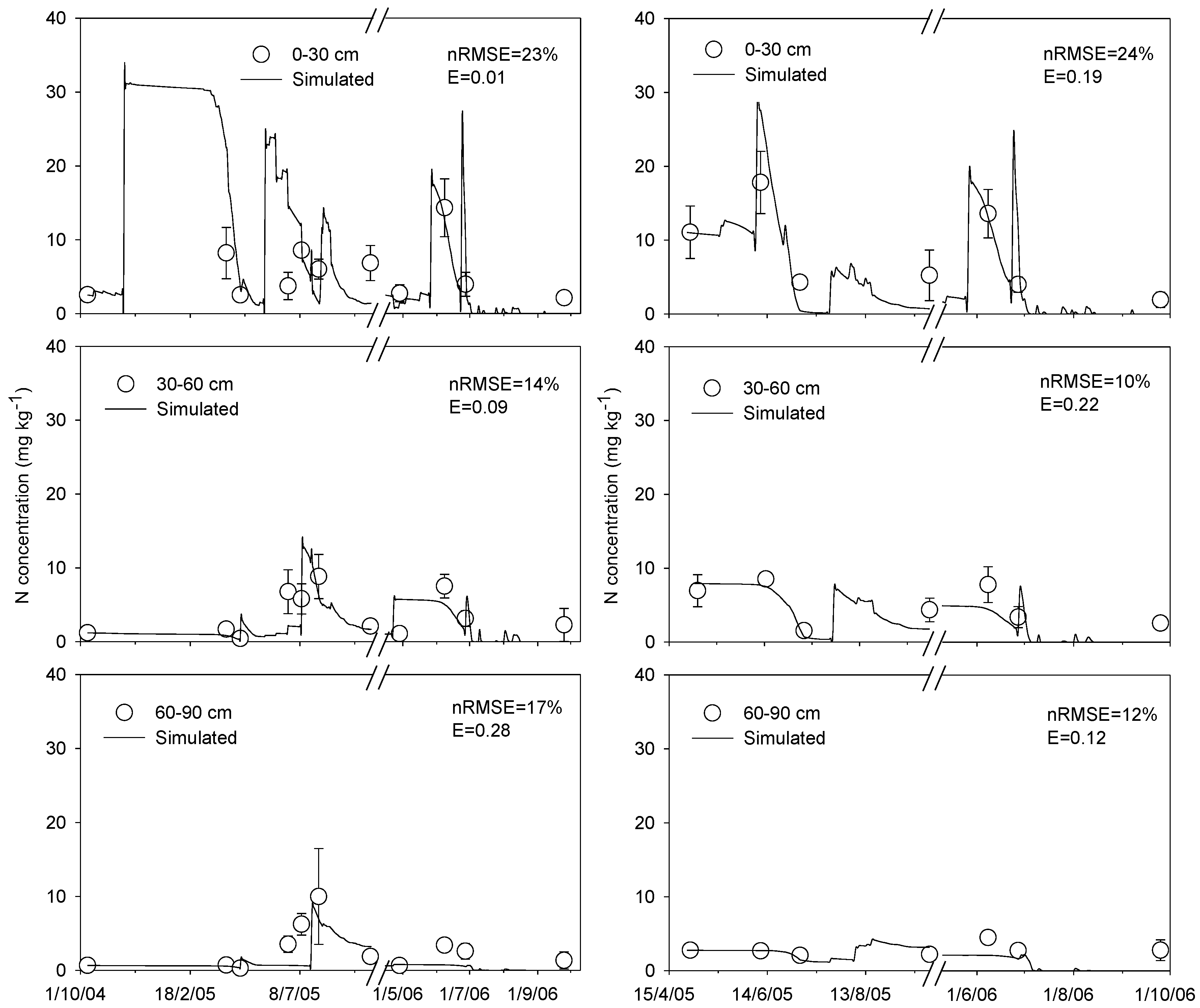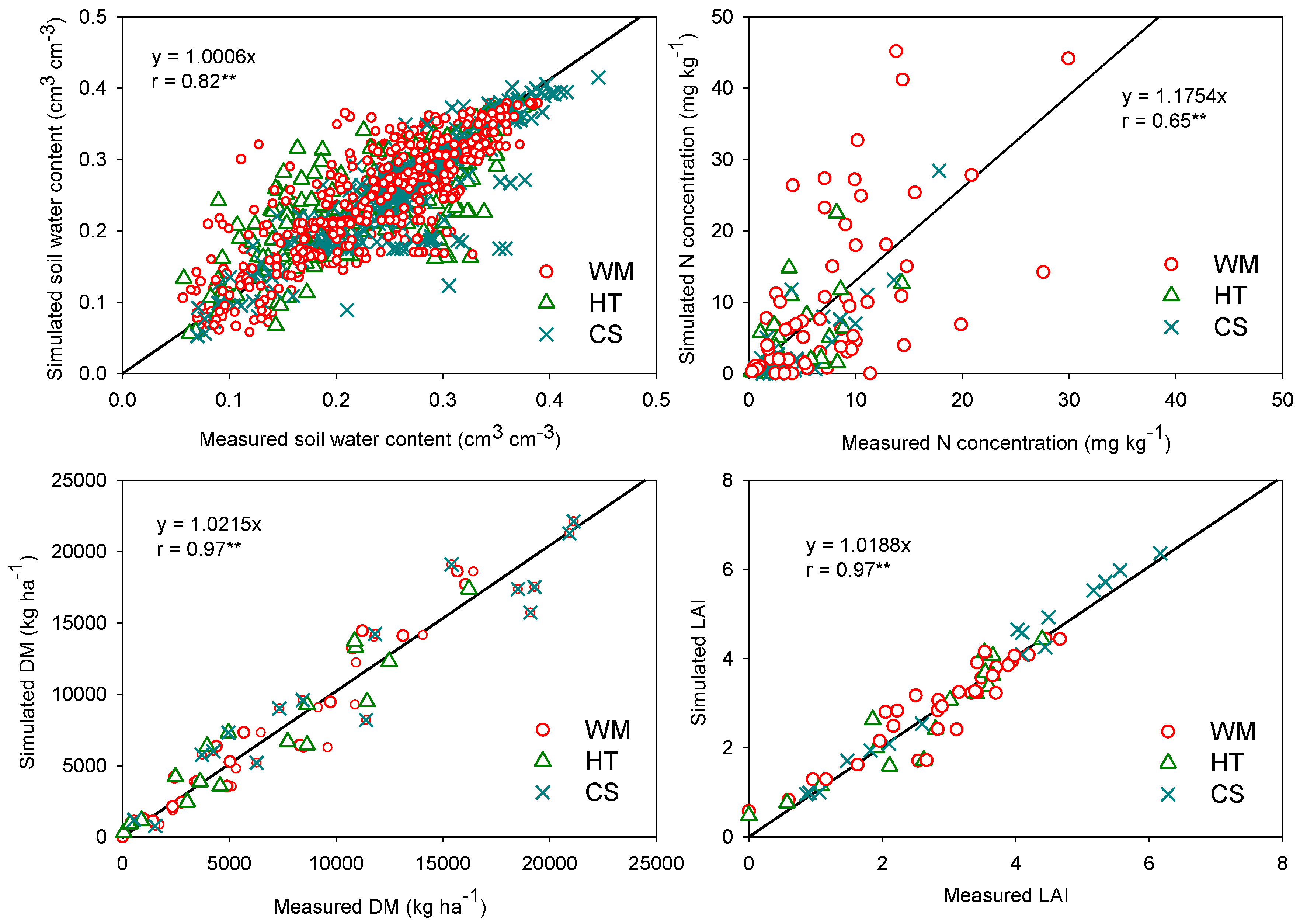Exploring a Sustainable Cropping System in the North China Plain Using a Modelling Approach
Abstract
:1. Introduction
2. Materials and Methods
2.1. Study Area
2.2. Experimental Design
2.3. Model Description
2.4. Model Parameters
2.5. Model Performance Criteria
3. Results and Discussion
3.1. Model Calibration and Validation
3.2. Water Balance and Water Use Efficiency
3.3. N Balance and N Use Efficiency
3.4. Comprehensive Evaluation of Different Cropping Systems
4. Conclusions
Author Contributions
Funding
Conflicts of Interest
References
- Sun, Q.P.; Kröbel, R.; Müller, T.; Römheld, V.; Cui, Z.L.; Zhang, F.S. Optimization of yield and water-use of different cropping systems for sustainable groundwater use in North China Plain. Agric. Water Manag. 2011, 98, 808–814. [Google Scholar] [CrossRef]
- Li, Z.J.; Hu, K.L.; Li, B.G.; He, M.R.; Zhang, J.W. Evaluation of water and N use efficiencies in a double cropping system under different integrated management practices based on a model approach. Agric. Water Manag. 2015, 159, 19–34. [Google Scholar] [CrossRef]
- Binder, J.; Graeff, S.; Link, J.; Claupein, W.; Liu, M.; Dai, M.H.; Wang, P. Model-based approach to quantify production potentials of summer maize and spring maize in the North China Plain. Agron. J. 2008, 100, 862–873. [Google Scholar] [CrossRef]
- Yang, X.L.; Chen, Y.; Pacenka, S.; Gao, W.; Ma, L.; Wang, G. Effect of diversified crop rotations on groundwater levels and crop water productivity in the North China Plain. J. Hydro. 2015, 522, 428–438. [Google Scholar] [CrossRef]
- Zhang, Y.Q.; Kendy, E.; Yu, Q.; Liu, C.M.; Shen, Y.J.; Sun, H.Y. Effect of soil water deficit on evapotranspiration, crop yield, and water use efficiency in the North China Plain. Agric. Water Manag. 2004, 64, 107–122. [Google Scholar] [CrossRef]
- Zhu, Z.L.; Chen, D.L. Nitrogen fertilizer use in China—Contributions to food production, impacts on the environment and best management strategies. Nutr. Cycl. Agroecost. 2002, 63, 117–127. [Google Scholar] [CrossRef]
- National Bureau of Statistics of China. China Statistical Yearbook 2018; China Statistics Press: Beijing, China, 2018.
- Ju, X.T.; Xing, G.X.; Chen, X.P.; Zhang, S.L.; Zhang, L.J.; Liu, X.J.; Cui, Z.L.; Yin, B.; Christie, P.; Zhu, Z.L.; et al. Reducing environmental risk by improving N management in intensive Chinese agricultural systems. Proc. Natl. Acad. Sci. USA 2009, 106, 3041–3046. [Google Scholar] [CrossRef] [PubMed] [Green Version]
- Zhang, M.; Tian, Y.H.; Zhao, M.; Yin, B.; Zhu, Z.L. The assessment of nitrate leaching in a rice–wheat rotation system using an improved agronomic practice aimed to increase rice crop yields. Agric. Ecosyst. Environ. 2017, 241, 100–109. [Google Scholar] [CrossRef]
- Yu, C.Q.; Huang, X.; Chen, H.; Godfray, H.C.J.; Wright, J.S.; Hall, J.W.; Gong, P.; Ni, S.Q.; Qiao, S.C.; Huang, G.R.; et al. Managing N to restore water quality in China. Nature 2019, 567, 516–520. [Google Scholar] [CrossRef]
- Leghari, S.H.; Hu, K.L.; Liang, H.; Wei, Y.C. Modelling water and nitrogen balance of different cropping systems in the North China Plain. Agronomy 2019, 9, 696. [Google Scholar] [CrossRef] [Green Version]
- Chen, C.; Wang, E.L.; Yu, Q. Modeling wheat and maize productivity as affected by climate variation and irrigation supply in North China Plain. Agron. J. 2010, 102, 1037–1049. [Google Scholar] [CrossRef] [Green Version]
- Liang, H.; Qin, W.; Hu, K.L.; Tao, H.B.; Li, B.G. Modelling groundwater level dynamics under different cropping systems and developing groundwater neutral systems in the North China Plain. Agric. Water Manag. 2019, 213, 732–741. [Google Scholar] [CrossRef]
- Kendy, E.; Gerard-Marchant, P.; Walter, M.T.; Zhang, Y.; Liu, C.; Steenhuis, T.S. A soil-water-balance approach to quantify groundwater recharge from irrigated cropland in the North China Plain. Hydrol. Process. 2003, 17, 2011–2031. [Google Scholar] [CrossRef]
- Sun, H.Y.; Zhang, X.Y.; Wang, E.L.; Chen, S.Y.; Shao, L.W. Quantifying the impacts of irrigation on groundwater reserve and crop production-a case study in the North China Plain. Eur. J. Agron. 2015, 70, 48–56. [Google Scholar] [CrossRef]
- Ministry of Agriculture and Rural Affairs. Notice of the 10 Ministries and Commissions of the Ministry of Agriculture on the Issuance of a Pilot Program to Explore the Implementation of the Arable Land Rotation System. 2017. Available online: http://www.moa.gov.cn/nybgb/2016/diqiqi/201711/t20171128_5921712.htm (accessed on 28 November 2017).
- Li, Y.; White, R.E.; Chen, D.L.; Zhang, J.B.; Li, B.G.; Huang, Y.F.; Edis, R. A spatially referenced water and nitrogen management model (WNMM) for (irrigated) intensive cropping systems in the North China Plain. Ecol. Model. 2007, 203, 395–423. [Google Scholar] [CrossRef]
- Sun, B.; Chen, D.L.; Li, Y.; Wang, X.X. Nitrogen leaching in an upland cropping system on an acid soil in subtropical China: Lysimeter measurements and simulation. Nutr. Cycl. Agroecosyst. 2008, 81, 291–303. [Google Scholar] [CrossRef]
- Hu, K.L.; Li, Y.; Chen, W.P.; Chen, D.L.; Wei, Y.P.; Edis, R.; Li, B.G.; Huang, Y.F.; Zhang, Y.P. Modeling nitrate leaching and optimizing water and nitrogen management under irrigated maize in Desert Oases in Northwestern China. J. Environ. Qual. 2010, 39, 667–677. [Google Scholar] [CrossRef] [PubMed]
- He, Y.; Hu, K.L.; Wang, H.; Huang, Y.F.; Chen, D.L.; Li, B.G.; Li, Y. Modeling of water and nitrogen utilization of layered soil profiles under a wheat-maize cropping system. Math. Comput. Model. 2013, 58, 596–605. [Google Scholar] [CrossRef]
- Yu, H.M.; Li, Z.Z.; Gong, Y.S.; Mack, U.; Feger, K.H.; Stahr, K. Water drainage and nitrate leaching under traditional and improved management of vegetable-cropping systems in the North China Plain. J. Plant Nutr. Soil Sci. 2006, 169, 47–51. [Google Scholar] [CrossRef]
- Chen, X.P.; Zhang, F.S.; Römheld, V.; Horlacher, D.; Schulz, R.; Böning-Zilkens, M.; Wang, P.; Claupein, W. Synchronizing N supply from soil and fertilizer and N demand of winter wheat by an improved Nmin method. Nutr. Cycl. Agroecosyst. 2005, 74, 91–98. [Google Scholar] [CrossRef]
- Zhao, R.F.; Chen, X.P.; Zhang, F.S.; Zhang, H.L.; Schroder, J.; Romheld, V. Fertilization and nitrogen balance in a wheat–maize rotation system in North China. Agron. J. 2006, 98, 938–945. [Google Scholar] [CrossRef]
- Cui, Z.L.; Chen, X.P.; Miao, Y.X.; Li, F.; Zhang, F.S.; Li, J.L.; Ye, Y.L.; Yang, Z.P.; Zhang, Q.; Liu, C.S. On-farm evaluation of winter wheat yield response to residual soil nitrate-N in North China Plain. Agron. J. 2008, 100, 1527–1534. [Google Scholar] [CrossRef]
- Allen, R.G.; Pereira, L.S.; Raes, D. Crop evapotranspiration: Guidelines for computing crop water requirements. FAO Irrigation and Drainage Pap. 56. Food Agric. Organ. United Nations Rome 1998, 300, D05109. [Google Scholar]
- Scotter, D.R.; Clothier, B.E.; Turner, M.A. The soil water balance in a fragiaqualf and its effect on pasture growth in Central New Zealand. Aust. J. Soil Res. 1979, 17, 455–465. [Google Scholar] [CrossRef]
- Van Genuchten, M.T. A Numerical Model for Water and Solute Movement in and Below the Root Zone; United States Department of Agriculture Agricultural Research Service US Salinity Laboratory: California, CA, USA, 1987.
- Williams, J.R. The EPIC model. In Computer Models of Watershed Hydrology; Water Resources Publications: Colorado, CO, USA, 1995; pp. 909–1000. [Google Scholar]
- Arnold, J.G.; Engel, B.A.; Srinivasan, R. Continuous Time Grid Cell Watershed Model. Application of Advanced Information Technologies. In Effective Management of Natural Resources; In-formation and Electrical Technologies; ASAE: Michigan, MI, USA, 1993. [Google Scholar]
- Li, X.X.; Hu, C.S.; Delgado, J.A.; Zhang, Y.M.; Ouyang, Z.Y. Increased nitrogen use efficiencies as a key mitigation alternative to reduce nitrate leaching in North China Plain. Agric. Water Manag. 2007, 89, 137–147. [Google Scholar] [CrossRef]
- Peng, Y.F.; Niu, J.F.; Peng, Z.P.; Zhang, F.S.; Li, C.J. Shoot growth potential drives N uptake in maize plants and correlates with root growth in the soil. Field Crops Res. 2010, 115, 85–93. [Google Scholar] [CrossRef]
- Nash, J.E.; Sutcliffe, J.V. River flow forecasting through conceptual models. Part I. A discussion of principles. J. Hydrol. 1970, 10, 282–290. [Google Scholar] [CrossRef]
- Yang, J.M.; Yang, J.Y.; Liu, S.; Hoogenboom, G. An evaluation of the statistical methods for testing the performance of crop models with observed data. Agric. Syst. 2014, 127, 81–89. [Google Scholar] [CrossRef]
- Ju, X.T.; Liu, X.J.; Zhang, F.S.; Roelcke, M. Nitrogen fertilization, soil nitrate accumulation, and policy recommendations in several agricultural regions of China. Ambio 2004, 33, 300–305. [Google Scholar] [CrossRef]
- Fang, Q.X.; Ma, L.W.; Yu, Q.; Malone, R.W.; Saseendran, S.A.; Ahuja, L.R. Modeling nitrogen and water management effects in a wheat-maize double-cropping system. J. Environ. Qual. 2008, 37, 2232–2242. [Google Scholar] [CrossRef] [Green Version]
- Hu, K.L.; Li, B.G.; Chen, D.L.; Robert, E. Simulation of nitrate leaching under irrigated maize on sandy soil in desert oasis in Inner Mongolia, China. Agric. Water Manag. 2008, 95, 1180–1188. [Google Scholar] [CrossRef]
- Dai, M.H.; Tao, H.B.; Liao, S.H.; Wang, L.N.; Wang, P. Estimation and analysis of maize potential productivity based on CERES-Maize model in the North China Plain. Trans. CSAE 2008, 24, 30–36, (In Chinese with English Abstract). [Google Scholar]
- Liu, M.; Tao, H.B.; Wang, P.; Lv, L.H.; Zhang, Y.J.; Zhang, L. Water consumption, soil water content variation and water utilization efficiency of different cropping system in China. J. Soil Water Conser. 2008, 22, 116–120, (In Chinese with English Abstract). [Google Scholar]
- Wu, Y.C.; Zhou, S.L.; Wang, Z.M.; Feng, H.Y.; Lu, L.Q.; Wang, R.Z. Recovery of Residual Fertilizer-Nitrogen by Wheat in a Winter Wheat–Summer Maize Rotation in the North China Plain: A Soil Column Study. Agron. J. 2009, 101, 925–932. [Google Scholar] [CrossRef]
- Xing, G.X. N2O emission from cropland in China. Nutr. Cycl. Agroecosyst. 1998, 52, 249–254. [Google Scholar] [CrossRef]
- Zhao, C.S. Analysis of potential high yield for maize in Beijing rural area. Beijing Agric. 1998, 5, 3–6, (In Chinese with English Abstract). [Google Scholar]
- Luo, J.M.; Shen, Y.J.; Qi, Y.Q.; Zhang, Y.C.; Xiao, D.P. Evaluating water conservation effects due to cropping system optimization on the Beijing-Tiajin -Hebei plain, China. Agric. Syst. 2018, 159, 32–41. [Google Scholar] [CrossRef]
- Kukal, M.S.; Irmak, S. Characterization of water use and productivity dynamics across four C3 and C4 row crops under optimal growth conditions. Agric. Water Manag. 2020, 227, 105840. [Google Scholar] [CrossRef]






| Soil Layer (cm) | Particle Fraction (%) | Soil Texture (USDA) | BD (g·cm−3) | pH | θs (cm3·cm−3) | θfc (cm3·cm−3) | θwp (cm3·cm−3) | Ks (cm·d−1) | ||
|---|---|---|---|---|---|---|---|---|---|---|
| Sand | Silt | Clay | ||||||||
| 0–15 | 30.8 | 52.6 | 16.6 | Silt loam | 1.33 | 8.0 | 0.411 | 0.285 | 0.100 | 29.8 |
| 15–30 | 34.6 | 47.8 | 17.6 | Loam | 1.35 | 8.5 | 0.469 | 0.375 | 0.200 | 11.4 |
| 30–60 | 16.4 | 56.8 | 26.8 | Silt loam | 1.52 | 9.1 | 0.450 | 0.315 | 0.225 | 15.6 |
| 60–90 | 30.7 | 47.6 | 21.7 | Loam | 1.42 | 8.8 | 0.420 | 0.300 | 0.210 | 18.8 |
| 90–120 | 35.0 | 46.4 | 18.6 | Loam | 1.47 | 8.5 | 0.425 | 0.305 | 0.220 | 13.6 |
| Date | Irrigation (mm) | Date | Fertilization (kg N ha−1) | ||||
|---|---|---|---|---|---|---|---|
| WM | HT | CS | WM | HT | CS | ||
| 2004/10/14 | 20 | 20 | - | 2004/10/10 | 60 | 60 | - |
| 2004/11/26 | 50 | 50 | - | 2005/4/7 | 30 | 30 | - |
| 2005/3/29 | - | - | - | 2005/4/24 | 100 | 100 | - |
| 2005/4/7 | 65 | 65 | - | 2005/4/27 | - | - | 30 |
| 2005/4/24 | 100 | 100 | 75 | 2005/7/4 | - | - | 65 |
| 2005/5/25 | 70 | 70 | - | 2005/7/11 | 30 | 30 | - |
| 2005/6/23 | 50 | 50 | - | 2005/8/2 | 45 | 45 | - |
| 2005/7/4 | - | - | 50 | ||||
| 2005/7/11 | 50 | 50 | - | ||||
| 2005/10/16 | 20 | - | - | 2005/10/11 | 50 | - | - |
| 2005/11/16 | 50 | - | - | 2006/4/17 | 85 | - | - |
| 2006/3/17 | 60 | - | - | 2006/6/28 | - | 70 | 70 |
| 2006/4/17 | 70 | - | - | 2006/7/8 | 50 | - | - |
| 2006/4/23 | - | 90 | 90 | 2006/8/7 | 90 | - | - |
| 2006/5/20 | 65 | - | - | ||||
| 2006/6/19 | 50 | 50 | 50 | ||||
| Rotation | Season | Pre (mm) | Irri (mm) | ET (mm) | Drainage (mm) | WSC (mm) | Measured Yield (kg ha−1) | Simulated Yield (kg ha−1) | WUE (kg m−3) |
|---|---|---|---|---|---|---|---|---|---|
| WM | 2004–05WW | 123 | 305 | 442 | 0 | −14 | 5033 ± 118 | 5131 | 1.14 |
| 2005SM | 274 | 100 | 310 | 34 | 30 | 8368 ± 510 | 8488 | 2.70 | |
| 2005–06WW | 49 | 265 | 314 | 0 | 0 | 3223 ± 260 | 3293 | 1.03 | |
| 2006SM | 511 | 50 | 339 | 180 | 42 | 6872 ± 287 | 6822 | 2.03 | |
| Sum | 957 | 720 | 1405 | 214(13%) | 58 | 23,496 | 23,734 | 1.67 | |
| HT | 2004–05WW | 123 | 305 | 432 | 0 | −4 | 4810 ± 618 | 4755 | 1.11 |
| 2005SM | 274 | 100 | 319 | 0 | 55 | 8307 ± 694 | 8360 | 2.60 | |
| 2006SPM | 514 | 140 | 409 | 204 | 41 | 6933 ± 742 | 7140 | 1.70 | |
| Sum | 911 | 545 | 1160 | 204(14%) | 92 | 20,050 | 20,255 | 1.73 | |
| CS | 2005SPM | 284 | 125 | 434 | 7 | −32 | 10,253 ± 549 | 10,406 | 2.36 |
| 2006SPM | 514 | 140 | 393 | 236 | 25 | 7723 ± 660 | 7726 | 1.97 | |
| Sum | 798 | 265 | 827 | 243(23%) | −7 | 17,976 | 18,132 | 2.17 |
| Rotation | Season | N Input (kg N ha−1) | N Output (kg N ha−1) | NUE | FNUE | ||||||||
|---|---|---|---|---|---|---|---|---|---|---|---|---|---|
| Nini | Nres | Nfer | Ndep | Nirr | Nnet | Nvol | Nden | Nup | Nlea | kg kg−1 N−1 | |||
| WM | 2004–05WW | 32.8 | 109.1 | 190 | 39 | 12 | 74 | 47.1 | 0.6 | 191 | 0 | 21 | 26 |
| 2005SM | 109.1 | 88.3 | 75 | 14 | 4 | 33 | 0.4 | 0.3 | 186 | 2.3 | 44 | 112 | |
| 2005–06WW | 90.0 | 81.1 | 135 | 39 | 10 | 25 | 16.4 | 0.4 | 201 | 0 | 15 | 24 | |
| 2006SM | 81.1 | 0.2 | 140 | 14 | 2 | 83 | 40.1 | 0.4 | 214 | 65.7 | 21 | 49 | |
| Sum | 32.8 | 0.2 | 540 | 106 | 28 | 215 | 104 | 1.7 | 792 | 68 | 24 | 44 | |
| HT | 2004–05WW | 35.8 | 107.1 | 190 | 39 | 12 | 60 | 39.7 | 0.6 | 189 | 0 | 21 | 25 |
| 2005SM | 107.1 | 48.3 | 75 | 14 | 4 | 38 | 0.4 | 0.3 | 190 | 0 | 44 | 111 | |
| 2006SPM | 21.3 | 0.1 | 70 | 53 | 5 | 59 | 17.5 | 0.2 | 190 | 0.1 | 33 | 99 | |
| Sum | 35.8 | 0.1 | 335 | 106 | 21 | 157 | 57.6 | 1.1 | 569 | 0.1 | 32 | 60 | |
| CS | 2005SPM | 102.8 | 38.8 | 95 | 53 | 5 | 62 | 33.8 | 0.4 | 243 | 1.6 | 37 | 108 |
| 2006SPM | 39.1 | 0.7 | 70 | 53 | 5 | 66 | 18.1 | 0.2 | 203 | 0.3 | 35 | 110 | |
| sum | 102.8 | 0.7 | 165 | 106 | 10 | 128 | 51.9 | 0.6 | 446 | 1.9 | 36 | 109 | |
© 2020 by the authors. Licensee MDPI, Basel, Switzerland. This article is an open access article distributed under the terms and conditions of the Creative Commons Attribution (CC BY) license (http://creativecommons.org/licenses/by/4.0/).
Share and Cite
Wang, H.; Li, B.; Jin, L.; Hu, K. Exploring a Sustainable Cropping System in the North China Plain Using a Modelling Approach. Sustainability 2020, 12, 4588. https://doi.org/10.3390/su12114588
Wang H, Li B, Jin L, Hu K. Exploring a Sustainable Cropping System in the North China Plain Using a Modelling Approach. Sustainability. 2020; 12(11):4588. https://doi.org/10.3390/su12114588
Chicago/Turabian StyleWang, Huanyuan, Baoguo Li, Liang Jin, and Kelin Hu. 2020. "Exploring a Sustainable Cropping System in the North China Plain Using a Modelling Approach" Sustainability 12, no. 11: 4588. https://doi.org/10.3390/su12114588





